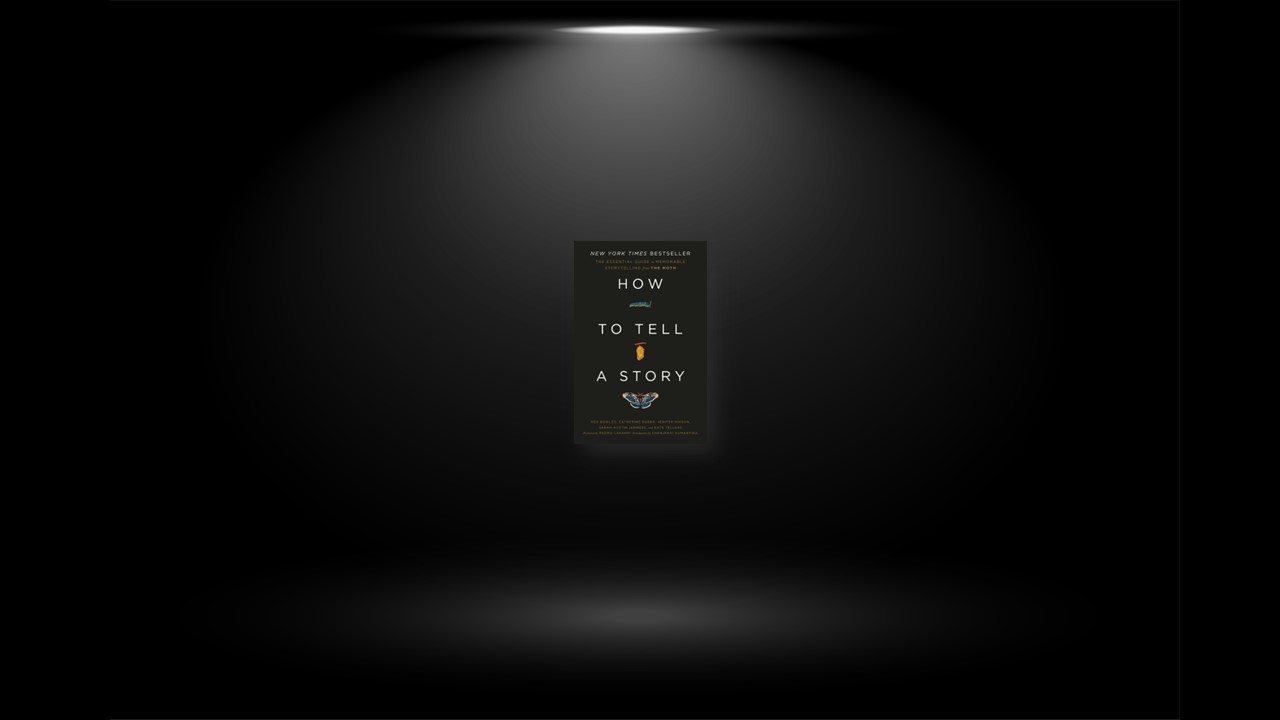Mining for Memories
You are bursting with stories! Where will you start? Think back through the moments in your life you’ll never forget—big events or smaller ones that changed you. If you have an inkling of a story idea, don’t shoot it down too quickly. Ponder it. Why does this moment stick with you? Think of moments where you made a conscious decision, big or small. What happened as a deliberate result of something you did or did not choose to do?
Consider how the story is personal to you. If you’re including something that happened to someone else, remember it must have a direct impact on you, or the other person should be telling the story. Can you remember a moment where it all went horribly wrong? How did you recover? What did you learn? Don’t be afraid to explore those uncomfortable moments and share the not-so-glamorous sides of yourself. Our biggest mistakes often lead to great stories! Those missteps make us human, and that vulnerability creates connection with your listener. Remember not to let a trauma or a struggle be the story, but rather the context of the story. Stories always need to go beyond “a bad thing happened.”
What was the inciting incident that set everything in motion? Perhaps you broke a pattern or interrupted your usual routine. What happened that shook things up? Think about moments that might have pushed you or pulled you in a different direction than you had planned. How might that moment have changed you?
The Foundation
Ask yourself: What are the stakes of your story? What did you feel you stood to lose or gain as a result? What did you most want/need/must have/couldn’t live without? Remember, stakes show us why you care, which tells us why we should care.
Does your story go beyond anecdote? You might have dramatic details or a string of amusing events, but it must go deeper! Ask yourself why this moment left a lasting effect on you so you can transform your anecdote into a story.
What is the arc of your story? Who were you at the beginning and who were you at the end? How were you changed? How do you live your life differently as a result of the events in the story?
What is the story ultimately about for you? How would you distill it down into one sentence? Remember, you can tell various stories using similar events—boiling it down to one sentence will give you the focus and clarity to guide and shape the story you want to tell.
The Materials
Identify the important information you need to build the arc of your story. Create a bulleted list of these narrative stepping stones. Which will become scenes, and which will be summaries or moments of reflection? What is your whole story building to? How will it resolve? Remember, you do not have to plot every literal step—jump cuts are allowed!
Once you determine which of your narrative stepping stones could be potential scenes, decide how you will bring them to life cinematically. Recount them so we can see and experience them with you. Some stories might have many small scenes, others might have only two or three, but remember there is usually one pivotal scene that your story builds toward.
Make sure to stay in the action and describe the scene from the inside. Allow the listener to experience your story by taking them through the events, the way they unfolded for you. Avoid telling from hindsight.
What are the details that will make your scenes (and your overall story) memorable and uniquely yours? Draw from all your senses. Choose specific details to highlight important moments, create emotion, and build tension in your story, but don’t go overboard with distracting or overly specific details that might risk confusing your listener. When in doubt, revisit your one sentence and determine if the detail supports the overall arc of your story.
Is there important backstory you need to drop in or weave through in order for your listener to understand the context of the story? How will you land your arc? How will you illustrate what changed for you? Can you show us how you are different now than you were at the start of your story?
Magnifying the Emotion
Punctuate your scenes with emotion. Put yourself back in the moment and describe how you felt both physically and emotionally. Your listener may not relate to a specific situation, but we all know what it feels like to be elated or embarrassed or so nervous your heart races. Emotions connect you to your listener and allow them to experience your story and feel what you were feeling. Remember, stakes aren’t possible without emotion.
A moment to laugh together is like a gift to the listener. It can be used to relieve the tension of a painful or suspenseful moment and can bond you with the audience. It can help illustrate your point of view or deepen our understanding of characters in your story. But the humor in storytelling should never feel forced. Your stories are best told in your authentic voice.
Are you ready to tell this story? You need distance and perspective to fully process an experience, or chances are you’re still living through it. Stories involving trauma or deep upset must be told from a place of healing. Strong feelings do not preclude you from sharing a story, but if you feel you’re not in command of your emotions, press pause until you’ve had a chance to more fully process. It is not a show of bravery to tell a story before you’re ready.
Structuring Your Story
How will you order the moments and scenes you’ve identified? Which structure will you choose? Pick the one that feels organic and best supports the story. Forcing the story into a complicated structure will make it feel overworked and will be harder for you to tell.
Would it be better to let the story unfold for the listener the way it unfolded for you? Would telling it another way spoil the surprise or the mystery? If so, then telling it chronologically is probably your best bet!
Flashbacks can support critical moments and change the listener’s perspective within the story. Use a classic flashback to temporarily pause a story and add necessary information. Choose a cliffhanger to add tension and create drama to give the story a running start. Or use multiple flashbacks to give backstory and illustrate motivations. Sometimes flashbacks are vital, but other times they simply help you draw a picture of a moment. Be careful to ensure your flashbacks support your story—you never want to risk confusing your listener!
Near the end of your story, you can call back to the very first scene to create continuity and help you land the arc. (Sometimes the arc comes full circle!) When dealing with traumatic, epic, or historic events, try to find a smaller, personal story to use as a frame or narrative thread. This helps ground the listener and allows them to relate to a story that might otherwise be hard to fathom.
Beginnings and Endings
Choose the opening and closing points of your story. Knowing where you begin and where you end will help you plot your course and define your arc. Beginning in the action of a scene can drop us into a moment in time and introduce us to key people in the story as well as the stakes. Always end in a place that is satisfying for the listener and unique to your overall experience.
UNSATISFYING ENDINGS…
- Feel too pat, perfect, or matchy-matchy.
- Are undefined or unresolved. (Never leave the audience wondering, What happened?)
- Tell the listener what to think. (No moral of the story is necessary. Tell us instead what you think and feel.)
STRONG ENDINGS…
- Come to a definite stop without meandering. (You want to land your ending!)
- Are rooted in the change you experienced.
- Answer the central question or conflict of a story.
From Page to Stage
When you say your story out loud for the first time, it will be long, because you’re remembering your way through it. That’s okay! As you tell it, listen to how you’ve structured and ordered your pieces. Is everything in the right place? Does it all flow together?
Listen for where you might make edits. Are there phrases that are redundant or too many details that might cause confusion? Is there a spot you trip up on every single time that you just need to let go? Is there something you say in two sentences that could be said in one? The more you tell it, the more efficient and comfortable you will become with your words.
There is no need to rush to the end. Savor certain moments and accelerate when the story calls for it. Lean into the quiet and more thoughtful moments, and enjoy the laughs when they come! Remember, your story is alive! It will be different every time you tell it. Your tenses may switch up or a detail might spring to mind as you remember the moments you’re describing. This is not a recitation.
Find a trusted ear to listen to a run-through of your story. Ask them the same questions you asked yourself. Is there anything confusing or distracting? Were there points in the story that felt superfluous? (Were you tuning out during that part about the goat?) Did they need more info about anything to better understand? If nothing else, a run-through with a trusted listener will help you build your confidence.
The World’s a Stage
The first minute of telling your story is usually the scariest, but once you settle in and feel the audience, it will get easier. Nerves are normal and expected. It’s how you manage them that counts! Find a way to pump yourself up or calm yourself down, whether it’s quiet affirmations and a cup of tea or blasting ABBA in your headphones before the big moment. Whatever works for you!
Before you begin, find a way to ground yourself. Plant your feet, stand up straight, take a deep breath. Don’t rush to the start; it will throw you off balance! Don’t be afraid if your nerves show—they only mean you care. Acknowledging your nerves to the audience is okay—it will only endear you to them. Trust and know that people want to hear from you, because who’s better than you? Water is your friend—have it handy. There is nothing worse than suffering through a dry mouth, for both you and your listeners!
If your story deals with an emotional subject, you will likely feel the emotion the first time you tell it to other people. Running your story with someone beforehand will show you where the emotions might creep in so they don’t catch you by surprise. If you need to, stop, take a breath, and feel the emotion. Don’t try to hold it back—you will only get more choked up.
Consider whether there are elements of your story that might need more context so your listener can understand and follow along. Technical, experiential, and cultural details may need more explanation, depending on whom you’re addressing.
Honor your lived experience and never base your story on what you think an audience wants to hear. Remember that where and when you tell your story is entirely up to you.


